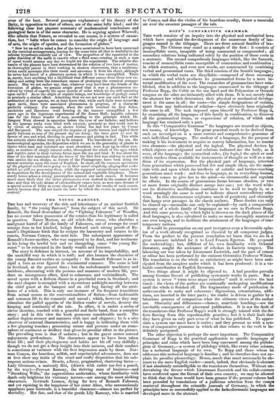THE YOUNG BARONET.
THE loss and recovery of the title and inheritance of an ancient Scottish family, by " the young Baronet," form the subject of this novel. Sir Renault, the lineal descendant of the "Fighting Falconers" of Woodlee, has no sooner taken possession of the estates than his legitimacy is called in question. Nance Morton, an old witch-like crone, who cherishes a malignant hatred of all the family of Falconers, out of revenge for cruel wrongs done to her kindred, brings forward such strong proofs of Re- nault's illegitimate birth that he resigns the baronetcy and estates to his cousin, Norman Comyn, the next heir. The subsequent appearance of Renault's foster-mother, who was supposed to be dead, and her testimony to his being the lawful heir and no changeling, cause "the young Ba- ronet" to be reinstated in the family wealth and honours. The story is deficient in interest, on account of its improbability, and the unskilful way in which it is told; and also because the character of the young Baronet excites no sympathy : Sir Renault Falconer is as in- sipid a hero as ever figured in sentimental romance. The scene is laid in Scotland, at the present time ; but the melodramatic machinery and incidents, alternating with the persons and manners of modern life, pro- duce an incongruous effect, fatal to coherence and verisimilitude. The novel opens with a Reform dinner in a provincial town in Scotland; and the next chapter is occupied with a mysterious midnight meeting between the chief guest at the banquet and an old bag having all the attri- butes of a witch. This is only one instance of the frequent transitions from actual scenes to the conventionalities of fiction—from fashionable and common life to the romantic and unreal ; which, however they may stimulate the palled appetite of the listless reader of novels, destroy the keeping and continuity of the tale. In effect, it is rather a series of clever sketches, touched with a graceful and facile hand, than a complete story : and in this view the book possesses considerable merit. The author depicts scenery and manners with tact and elegance; he is a nice observer of external characteristics, and is happy in indicating them with a few glancing touches ; presenting scenes and persons under an atmo- sphere of sentiment or drollery that gives its peculiar effect to the picture. The prevailing tone is that of sadness ; but in the gayer scenes sensual enjoyments predominate. The characters appear to have been taken from life ; and their physiognomy and habits are hit off very skilfully; though we do not get a deep insight into their natures, and their conduct is sometimes at variance with the first impression made by them. Nor- man Comyn, the heartless, selfish, and unprincipled adventurer, does not at first show any traits of the cruel and crafty disposition that his sub- sequent actions evince. Drurie, a fussy, pragmatical, chattering factor— Lady Glemnore, a matronly flirt, (drawn with rather too free a pencil, by the way)—Provost Ramsay, the thriving man of business—and "Streeking Willie," the superstitious undertaker, whose familiarity with death only heightens his visionary terrors—are among the most striking characters. Gertrude Lennox, dying for love of Renault Falconer, and yet rejoicing in the happiness of her sister Aline, who unconsciously supplants poor Gertrude, is a beautiful character—almost too perfect for mortality. Her fate, and that of the gentle Lily Ramsay, who is married
to Comyn and dies the victim of his heartless cruelty, throw a mournful air over the sweetest passages of the tale.


























 Previous page
Previous page